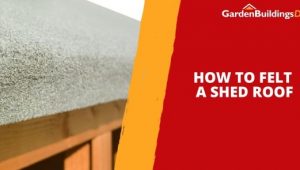Jump to:
It’s true that the thicker the cladding is, the better protection and insulation it can provide. There are standards, but options often depend on the style and manufacturer.
In this guide, we’ll use wooden shed cladding as a reference. It should help you narrow down your options before buying. Ready?
A Look at Wooden Shed Cladding
![[Wooden Shed Cladding] BillyOh Master Tongue and Groove Apex Shed](https://blog.gardenbuildingsdirect.co.uk/wp-content/uploads/2025/05/wooden-shed-cladding-thickness-guide-1-master-apex-shed.jpg)
Wooden shed cladding, as the name suggests, is made of panels made from wood. These are fixed to the outside frame to form the outer walls.
Not every shed comes with cladding, though. Some are built using basic construction without the extra boards. If cladding is part of the design, you’ll come across one of three common styles:
- Overlap cladding: Boards are laid horizontally, each one overlapping the board below it. It’s a straightforward design that still helps keep out the weather.
- Tongue and Groove (T&G) cladding: Each board has a tongue on one side and a groove on the other, linking edge to edge. They join to form a tight, flat surface with no visible gaps. The result gives the shed a strong, weather-resistant, and polished look.
- Shiplap cladding: This style is like a combination of both overlap and tongue & groove. The boards fit together with groove fittings, but with a bottom lip that overlaps the thinner part of the board below. This gives the shed a curved finish that helps rainwater run off. However it is slightly thinner than tongue & groove cladding.
Each of these styles comes in different thicknesses, which we’ll cover next.
Different Shed Cladding Thickness
Most garden sheds come with cladding that’s around 7mm to 11mm thick. There are thicker options too, like 19mm, 28mm, or even 44mm. They’re ideal for something sturdier or better insulated, especially for year-round use.
Overlap does offer weather protection, but the boards are thinner, around 7mm. It’s great if you don’t need heavy insulation and plan to use it for light storage or seasonal use.
Tongue and groove comes in various thicknesses, from 11mm up to 15mm on panel-based sheds. The tight fit and thicker boards block out draughts and stop moisture from getting in. It’s a worthwhile investment if you need solid insulation and year-round use.
Tongue and groove connections are also used on log cabin sheds. These are available in 19mm and 28mm thickness, but the main difference is that the logs span a much longer length along the walls, and they are constructed log-by-log instead of with panels. The added thickness of this option makes them an attractive option for shed enthusiasts looking for a warm workshop space.
However, actual insulation built into the walls works better for warmth than just making the walls thicker. Check out our guide for Cheap Ways to Insulate a Wooden Shed.
![[Wooden Shed Cladding] BillyOh Clubman Heavy Duty Shed Log Cabin](https://blog.gardenbuildingsdirect.co.uk/wp-content/uploads/2025/05/wooden-shed-cladding-thickness-guide-2-billyoh-clubman-log-cabin.jpg)
A good example is our BillyOh Clubman Heavy Duty Shed Log Cabin. It comes in 19mm and 28mm T&G cladding, with the standard 11mm T&G floor and roof.
And if you already own a shed but the cladding isn’t thick enough, insulation can help. You can do this yourself or hire a professional if you’ve got the budget. If not, our guide on How to Insulate a Garden Shed for Cheap has you covered!
How Shed Cladding Thickness Affects Weather Performance
Thicker cladding doesn’t just mean better insulation but also stronger weather protection. With a greater level being more durable and resistant to damage from wind, rain, and snow.
Let’s say you’re using your shed in tougher conditions—thicker cladding gives you peace of mind. Take T&G cladding, between 19mm and 44mm, for instance. It’ll do a better job of blocking moisture and keeping the shed warmer and drier.
Thinner cladding still does the trick if you’re using the shed for lighter storage or seasonal use. It might not offer the same level of insulation or weather protection, but it’s still durable. This makes it enough for less demanding conditions.
Round-up
So, how thick should shed cladding be? Well, it comes down to how you plan to use your shed.
For regular use with weatherproofing, go for the thicker side, especially with T&G boards. If it’s for light storage or occasional use, thinner cladding like overlap might do the job just fine.
There’s no one-size-fits-all answer. But knowing the styles and what each thickness is suitable for makes it easier to choose what’s right for you!
Garden Buildings Direct offers a range of garden rooms with T&G cladding. Browse our selection beyond sheds, including 19mm log cabins and 28mm log cabins.
For help choosing your new garden shed, check out of shed buying guide.
Read this guide next to learn more: The Best Wooden Shed Cladding Ideas





